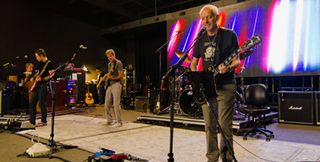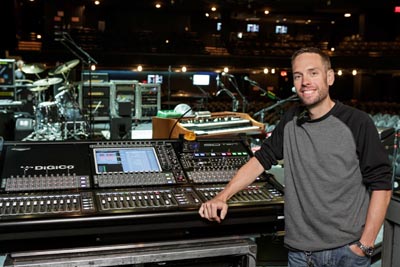- Peter Frampton reclaims his guitar throne on the blockbuster ‘Frampton’s Guitar Circus’ tour, which kicked off at the end of May in Nashville, TN at the Ryman Auditorium. The guitarist-turned-frontman/singer is sharing the stage and going toe-to-toe with a dizzying array of axemen on the summer outing including Steve Cropper, Dean DeLeo (Stone Temple Pilots), Don Felder (formerly of The Eagles), Mike McCready (Pearl Jam), Vince Gill, David Hidalgo (Los Lobos), Davy Knowles, Roger McGuinn (founder/lead guitarist of the BYRDS), Richard Thompson, Vernon Reid (Living Colour), Vinnie Moore (UFO) and Rick Nielsen (Cheap Trick), with B.B. King, Steve Lukather, Kenny Wayne Shepherd and Sonny Landreth trading off opening the shows.
With Clair Global providing the consoles and a full stage package, Frampton engineer Matt Fitzgerald—who has worked with Frampton for the past four years, and with Ringo Starr and Blue Man Group prior—kicked off the tour with a new audio footprint at monitor world to handle all of the ramped-up monitoring requirements. Fitzgerald chose a DiGiCo SD10 for Frampton’s 5-piece band and the guest guitarists.
Heading into rehearsals with the new system, Fitzgerald was a bit hesitant at first, but his fears were allayed once he powered up on day one. “This was my first experience using one of the new SD consoles in-depth,” he explains. “I’d had lots of mixing experience on a D5 working with opening acts. But for this summer tour, I opted in favor of a smaller footprint and more flexible solution by trading up two linked digital desks that I was using prior for an SD10. Not only was it difficult mixing inputs between the two desks, but it was sluggish also as I had to treat each one as an individual mixing surface.
“Obviously making a big switch was a bit nerve-wracking. Peter’s the kind of guy that wants to be able to walk into rehearsal and just go. I did a lot of research and spent time with DiGiCo’s Ryan Shelton in Nashville and worked with the offline software to build my big session files. We had a decent amount of rehearsal time, about two weeks, because the band was learning the other guitar players’ material, so that was of huge benefit to me. I was able to get really comfortable on the desk, storing snapshots, making scene-to-scene files, etc. Literally after the first day, I was shocked at how easy it was to get around on the desk and how small the learning curve was. I felt like a burden was lifted off my shoulders and I was able to just concentrate on mixing, not on the new gear. I was really blown away by the desk and really liked that everything was laid out so naturally. The buttons were right where I needed them, not to mention that you can have the channel strip wherever you want and create the desk to make it the way you want it to be. It’s really comfortable and I really enjoy it.”

With all of our band on Westone ES2 in-ears, Fitzgerald was looking at a lot of variables with the guest guitarists—some would be on ears, some on wedges; some had big stereo rigs and others had simple combo amps, acoustic guitars, etc. “I wanted to have a lot more flexibility and room to grow. With the SD10, I’m able to build a bigger show file as well as have extra wedge and ear mixes built-in. And it’s been awesome as far as changing the layout of the desk from show to show. For instance, we just played with Steve Cropper, who uses wedges, and I was able to move my wedge mixes to my top layer and restructure my file, and it was easy.”
Fitzgerald makes use of all of the onboard effects from the desk: reverbs for drums, acoustic guitars and keys, slap delays for vocals, plus a bit of multiband compression for vocals and DiGiTuBes on the bass for a little bit of drive. The only external effects he’s employing is an Eventide H3000 harmonizer for the acoustic guitars.
One of the challenges is creating a controlled environment on a day-to-day basis, blending the audience mics and stage sounds in everyone’s in-ears. “The tonality, spaciousness and imaging are great and big-sounding on this desk. There’s a real clarity to the sound. Any inputs like Peter’s LCR Marshall and stereo Leslies for is his guitar rig, the Hammond organs and keyboards that are hard-panned left and right, sound so clear and natural. The imaging is excellent and sounds like you don’t have ears in at all. I’m able to fine tune the EQ of the audience mics to each room, so the audience sounds the same even though you’re in an arena, theater, or event hall… When someone in the audience yells in between songs I want Peter to be able to look into the audience and know where and who is yelling and make eye contact with them. With the SD10s imaging and clarity I can pan audience mics exactly where I want. It’s as if I’m mixing the audience just as much as I mix the band. Peter’s mix is a very full range, dynamic mix of the entire band with his inputs just top,” he adds. “He wants to hear everybody and what they’re playing. If someone solos I ride my programmed control groups to give them a nudge in his ears so he hears all important parts of the songs…”
With the tour well underway, the feedback on the new console among band and front man has been positive. “This band is great to work with because they respect my input and ideas as we move forward with this new console. I try to open up the spectrum in their ears and create a ceiling for them instead of monaural mixes. I want it to sound as natural as possible and at the same time have full control of what’s going on onstage so I’ve created a big open stereo spectrum with Peter in middle and the guitar players panned on each side to create that image of what’s really going on onstage. If you take your ears out, that’s what it’ll sound like. And the fact that I’m able to recreate all of this in the in-ear monitors and have it sound so natural is really cool.
“And Peter, being an audio guy himself is great to work with, he is very particular about his sound,” Fitzgerald continues. “He’s involved in a lot of choices in the audio spectrum and loves this desk, too. Peter and his band are all on in-ears monitors and we have a couple of subs onstage for feel. I’m able to have a nice, controlled environment and a lot of good mixing. So far, it’s been a seamless transition!”
“This DiGiCo desk is amazingly ‘analog’ sounding,” raves Frampton. “It’s very warm and, with its full band width, has incredible smooth high-end response. Matt can run monitors and multi-track record every show with ease. This is due to the foresight of design. It’s like not having ‘ears’ in but instead, listening to a really great pair of studio monitors. But… I’m playing live on stage!”










